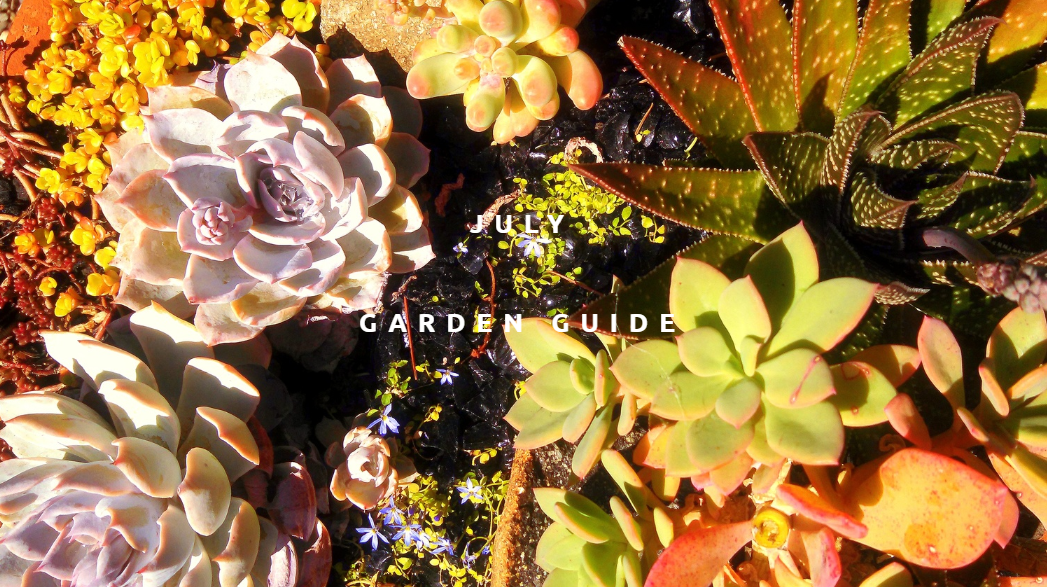What To Plant
Successive plantings of vegetables will prolong the harvest. Veggies need to be planted every three weeks or so to maintain a continual harvest throughout the season. Or choose early AND late producing varieties to extend your harvest. As plants reach the end of their production, remove them from the garden.
Our Bedding Department is overflowing with colorful blooms that would love to brighten up your garden.
Try portulaca, lantana, verbena, bush germander, coreopsis, and rockrose if you’re looking for plants that love the heat and whose blooms will beautify your garden this month.
Refresh your house plants by moving them outside into a spot with bright shade for a few weeks in the summer. Give them a bath with your garden hose. They will likely require more water so keep a close eye on them.
Fruit trees like figs, persimmons, and pomegranates are exciting to plant because they’ll have ripe fruit shortly after you plant them! Any fruit tree planted now will do great though, even if you have to wait until next year for your first harvest.
July Bonus: Tips For Drying Herbs
As temperatures warm herbs grow and produce lots of foliage. Now is a good time to think of drying some for future use in the Fall and Winter.
For large-leafed herbs such as basil, rosemary, and sage it’s as easy as hanging them upside down in a warm, dry place! Be sure your location has good air circulation and is protected from direct sun exposure. Simply snip off herb stems, tie the cut stems together with twine, and hang each bundle upside down. The herbs should be dry and crisp after about two weeks. Once dried, strip leaves off stems. Store the leaves in an air-tight container and keep them out of the sunlight.
For fine-leafed herbs such as oregano and thyme, remove foliage from stems and spread the leaves out on a flat surface. Let them dry in a warm and dry location out of the direct sunlight. Stir them every few days; once they feel crisp, store in an airtight container.
Plant Protection
Mulching makes the summer easier on your garden! Mulching retains moisture and helps minimize weeds. Use a 3 to 4 inch layer of G&B Soil Builder Conditioner and save up to 40% on your landscape water bill!
Watering is important during the summer months, but avoid the mistake of watering in the evening when fungus can attach itself to damp leaves. Established plants need regular deep soakings and mulching makes a big difference in keeping roots cool.
Fallen fruit, vegetables, and flowers can play host to various pests so be sure to clean up your garden regularly.
Maintenance & Fertilizers
Remember to water plants under eaves and in hidden corners. Soak hanging baskets and container plants during the summer heat.
Water your bougainvillea vines less while they’re blooming to ensure the brightest colors.
Don’t prune severely in summer. Thin plants lightly instead.
July is a good month to make sure all your plants are fed. When plants are on different feeding schedules some can get forgotten. Organic fertilizers like Dr Earth bring longer lasting results. Choose a relatively cool week to do this task.
Monthly fertilizing and deadheading (removing) spent blossoms are the keys to continued blooms from your flowering plants this summer.
Fruit Trees
Almond fertilize young trees / irrigate / harvest / remove and destroy fallen fruits
Apple fertilize young trees / fertilize mature trees / irrigate / control codling moth
Apricot fertilize young trees / irrigate
Cherry fertilize young trees / fertilize mature trees / summer pruning / cover with bird netting / harvest
Fig fertilize young trees / irrigate / harvest
Peach/Nectarine fertilize young trees / irrigate / summer pruning / harvest
Pear fertilize young trees / fertilize mature trees / irrigate / control codling moth / harvest
Pecan fertilize young trees / summer pruning of young trees / aphid control
Persimmon fertilize young trees / summer pruning / irrigate
Pistachio fertilize young trees / irrigate
Plum/Pluot/Prune fertilize young trees / irrigate / summer pruning / harvest
Quince fertilize young and mature trees / irrigate / control coddling moth / harvest
Pomegranate fertilize young and mature trees / irrigate
Walnut fertilize young trees / irrigate / remove and destroy fallen nuts
When irrigating, provide enough water to wet the soil 18” to 24” down. If using drip irrigation, place emitters in a circle around the tree at the drip line/canopy, not at trunk. Water deeply as needed instead of frequently and shallowly.

